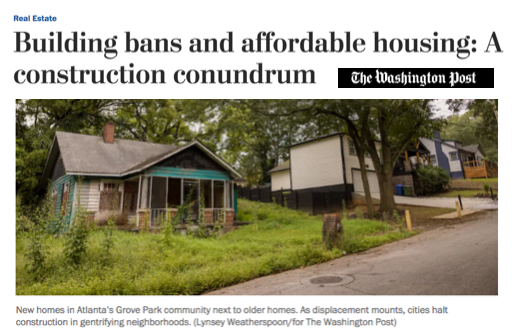Banning new construction is a great way to push up home values and accelerate gentrification
Cities are conflicted and confused about how to protect affordability
“Stop the world – I want to get off” was the title of Anthony Newley’s 1961 musical, but it seems like the core policy vision of a growing number of urban leaders faced with gentrification. An article earlier this month in the Washington Post portrayed building moratoriums put in place in Atlanta and Chicago in order to fend off gentrification. These efforts are certain to backfire.

As we wrote back in February, Atlanta’s ban on new building permits near the improved Westside Park at Bellwood Quarry is simply going to push up demand for existing housing. If prospective buyers can’t find a home in a new condominium or apartment building, they’re likely to bid up the price of existing housing in the area. Lessening the competition is a bonanza for house-flippers.
Still, the Washington Post seems at best, puzzled about what’s going on: The article is titled “Building bans and affordable housing: a construction conundrum.” The article says city officials and residents in both Atlanta and Chicago hope that bans will keep things from changing. But bans aren’t a conundrum: they’re simply counterproductive, if your aim is to encourage affordability. In the face of growing demand for urban living in places like Atlanta’s Westside Park and Chicago’s 606 Trail, limiting the supply of new housing only accelerates inflation. Moratoria and bans may create the illusion that something is being done, but residents will quickly find that prices will simply keep rising. (For the record, this isn’t the first time we’ve questioned the Post’s grasp of housing economics).
The housing contradiction: Affordability vs. wealth building
At City Observatory, we’ve long emphasized the fundamental contradiction between America’s two prime housing policy goals: promoting affordability and building wealth. Housing can’t build wealth unless it appreciates; and by definition, appreciation means housing is getting more unaffordable. That contradiction is very much in evidence in Atlanta.
A recent series of investigative reports by public radio station WABE, relates instances in which cash buyers and home flippers are buying up homes in the Black neighborhoods near Atlanta’s Beltline. Current homeowners are often unaware of the current value of their home, and buyers with a wad of cash (and better knowledge about the housing market) can swoop in and buy a property for much less than its market value. That’s led local officials to call for better education and awareness; Georgia State’s Dan Immergluck thinks seller’s ought to be provided with a current Zillow or Redfin estimate of the value of their home prior to finalizing any sale.
It’s easy to have mixed emotions about the potential windfall these long-time homeowners may receive (assuming they’re not hustled). On the one hand, this is very definition of neighborhood change and “displacement.” These folks are going to sell their homes and, in all likelihood, move out of the neighborhood. The new residents will likely be younger, better educated, and whiter. But, on the other hand, these sellers will have gotten some wealth via homeownership. As Andre Perry and his colleagues have documented, houses in predominantly Black neighborhoods have historically sold at a twenty percent discount to otherwise similar homes in predominantly white neighborhoods; the appreciation gained by these sellers signifies that at least in this neighborhood, Black homeowners are starting to close that gap. And that’s a stark contrast to the situation that Pete Saunders has described in predominantly Black neighborhoods in Detroit and other Midwestern cities, where homeownership has been a millstone, rather than a gold mine, for Black households. From a purely financial standpoint, for current Black homeowners, the only thing worse than having your neighborhood gentrify, is not having it gentrify.
What’s a city to do?
The underlying problem of many depressed urban neighborhoods is the problem of disinvestment. When some new investment finally comes to these places (whether public investment, like the improvements to Westside Park, or new residential construction), that’s a potential opportunity to help improve the economy of the area. Rising rents worsen affordability, but as we’ve suggested at City Observatory, tapping rising property values (and associated tax revenues) through tax increment financing, can provide a way to acquire or build affordable housing in the neighborhood as a way of making the sure the neighborhood is accessible to households with a range of incomes as investment proceeds.
What’s really clear is that building bans simply make the problem worse, and create a field day for flippers. Much as we might like to stop the world and get off, that’s not an option. Cities have to figure out ways to make change and new investment work for a broad segment of the community.
